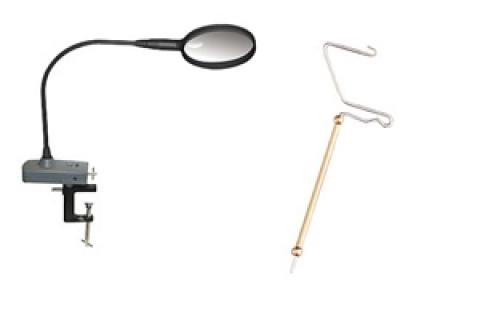
When I look back at the personal advances I’ve made in my fly tying over the last few years, one thing stands out: good tools really make a difference.
 |
| A whip finishing tool comes in handy for those smaller flies. |
Two tools, in particular, have helped me up my game.
The first one is the flexible Carson’s Magnifly Lighted Magnifier, a brilliant little portable magnifying light that helps these middle-aged eyes see what these middle-aged hands are doing. I’ve written about this in a previous blog so I won’t say any more other than it really does help a tyer create nicer flies and tie smaller patterns.
I highly recommend it.
The other tool that has really helped me up my game is the simple whip finishing tool.
I’ll confess that, though I’ve been tying flies for more than 30 years, I only started using a whip finishing tool about 3 or 4 years ago. Till that point I was whip finishing with my fingers or throwing half-hitches over the head of a fly using the end of a ballpoint pen. Both techniques worked just fine too, but again, were often problematic when tying smaller flies.
When I started using a whip-finisher sent to me by my nephew, the durability and heads of my flies started to improve considerably — and I was able to tie on tiny hooks that had previously presented a challenge to me.
It took a while to get used to using the tool, but I found the more I used it, the more second nature it has become. And while I always had problems understanding the process when it was explained to me in books, online videos have changed that.
Perhaps you’ve already discovered these things. The point is that good, quality-made tools, from scissors to bobbins, can make a huge difference in the enjoyment of and quality of fly tying. Anyone who has ever tried tying flies with a cheap set of hackle pliers can attest to this much.
That’s why I’m always on the lookout for new tools that can contribute to my never-ending quest to be a better fly tyer. For instance, before I start tying in earnest this year, I’m thinking of ordering a few ceramic bobbins. It’s time to improve that end of things.
The good news is that the beginning fly tyer doesn’t need all this stuff at once. Add a little at a time to your tool set, however, and soon you’ll be tying a little more effortlessly and wondering what happened to all the little frustrations that formerly accompanied a fly tying session.
Hey, it’s supposed to be relaxing. Why not do your best to ensure this is the case?
- 3357 views

